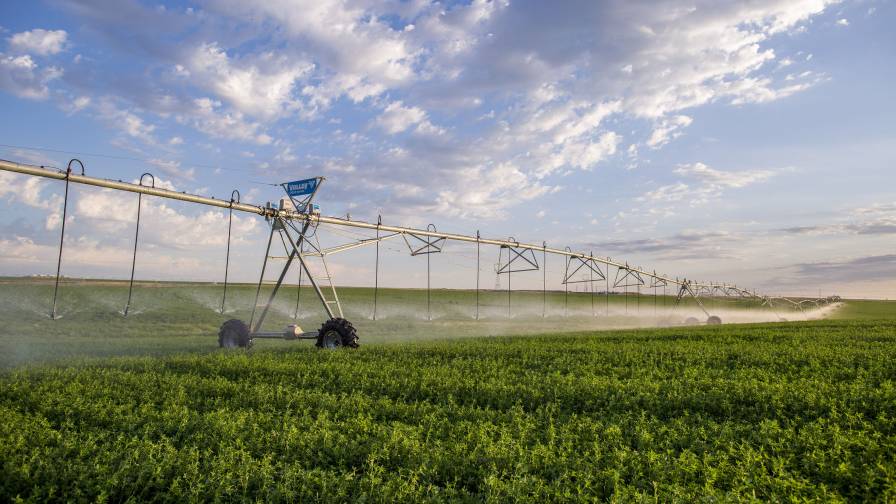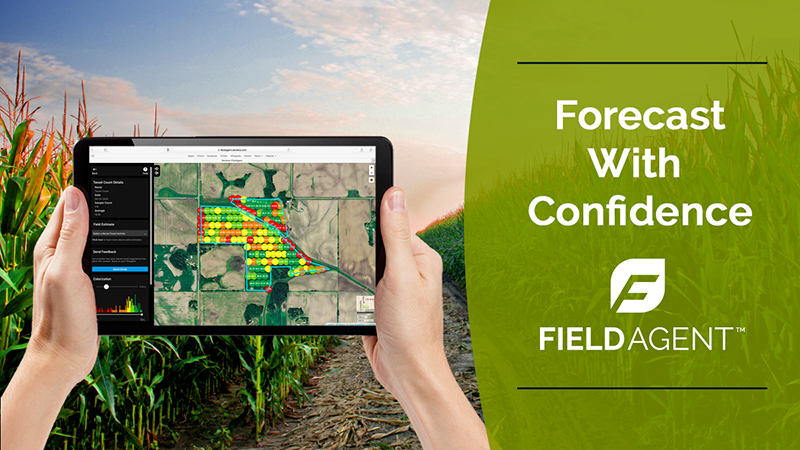4 Important Ways Precision Technology Is Impacting Irrigation

Variable rate irrigation (VRI) can allow growers to address field variability and potentially conserve resources and improve yield. Photo: Copyright Valmont Industries, Inc. All rights reserved.
Water management is becoming an increasing concern in agriculture, whether that’s dealing with too much or too little water. This is highlighted by recent events such as last year’s drought in California, flooding in Southern Texas, and depleting aquifers, such as the Ogallala that lies beneath several Midwestern states. Finding tools and methods to better manage water is critical to the future success of farming, not just in the U.S. but also globally.
In addition to better water-use efficiency and potential to help conserve this important resource, precision irrigation helps growers manage other precious resources more effectively, produce healthier crops and larger yields, and make a difference in nutrient and disease management.
Precision agriculture technologies are finding their way into many facets of farming. In recent years, there have been several key advancements that have made this technology practical in irrigation.
Drip Irrigation
Drip irrigation is among the most exciting developments in irrigation technology. Forms of drip irrigation have been around for millennia with the early use of clay pipes or pots, but recent advancements in plastics have made products like those from Netafim reliable and effective enough to use on a large scale.
MORE BY NATE DORSEY
Sensor Trends in Agriculture: Finding the Balance Between Affordable and Expensive
Drip irrigation is capable of what many would consider “precision irrigation” or “variable rate irrigation” (VRI) by the use of pumps and valves that can be manually or automatically controlled, even down to the individual plant level. This level of control can dramatically increase irrigation efficiency and provide substantial water savings.
In addition to water savings, drip irrigation has many other benefits. Among these is the ability to fertigate, or apply plant nutrients with the irrigation water. This allows the nutrients to get directly to the plant, where they can be taken up and used more effectively. This also helps to prevent nutrient loss through volatilization and leaching, protecting the high investment that growers make in plant nutrition products.
While drip irrigation offers many advantages, it can be expensive to install and maintain, so the investment must pencil out. In areas of the country where farmers rely on water allocations and pay for water per acre foot, such as in much of the Western U.S., the cost savings can easily outweigh the initial investment. In other areas of the country with seemingly extensive surface and groundwater resources, the benefits to the grower may be less clear in the short term, but there may be long-term advantages for these water sources.
Variable Rate Irrigation
Soils, topography, nutrient availability, and crop growth all vary spatially in fields. Because of this, different areas of the same field can have different irrigation needs. Variable rate irrigation (VRI) can allow a grower to address this variability and potentially conserve resources and improve yield.
Similar to other variable rate applications, a VRI prescription can be created by the grower or a trusted advisor and implemented by the irrigation system. This may include managing different zones of a field, or even getting down to the resolution of managing individual plants. This can have applications for large fields of commodity crops, vineyards, and even horticultural operations as well.
Variable rate irrigation systems can be integrated into most irrigation systems including micro-sprinklers, drip, and overhead sprinklers by incorporating the right controllers and software. These systems can be quite complex depending on needs and preferences of the grower, and often require working with a team of irrigation specialists and engineers to develop a plan and list of needed equipment.
As VRI technology continues to develop, it’s likely that we’ll see leading manufacturers develop standards and equipment that will be more interchangeable and customizable. For example, Valley Irrigation, one of the leading center pivot manufacturers, now offers a VRI system that’s interchangeable with most other competitive brands, allowing them to work with other systems that a grower may already have on the farm.
GPS Technology
Understanding field conditions and spatial variability is very important for any precision agriculture application. In fields, the topography, soil texture, and crop growth can vary, all of which can impact water needs and availability. To manage these fields, a thorough understanding of this variability and its precise locations in the field is necessary.
Global Position Systems (GPS) have become ubiquitous today, and this accessibility has enabled precision agriculture and is now finding its way into irrigation. In the field, geolocation of management of zones, utilization of VRI, and understanding data from soil moisture probes all rely on GPS technology.
Monitoring and Automation
The key to managing anything, whether that’s people, processes, or even water, is to have clear objectives in mind. Often, these should be measurable. It can be a challenge to manage water, especially on instinct alone. There are many systems on the market that allow growers and consultants to view real-time data on soil and weather conditions to help them make better management decisions. Examples include John Deere Field Connect, Lindsay Corp.’s Growsmart, and even smaller DIY solutions such as those from Wildeye.
Some of these systems not only allow growers to monitor soil and weather conditions, but can also allow them to remotely control irrigation systems, such as turning pumps, center pivots, and other systems on and off. This can help make a grower’s job easier by allowing them to control systems from the office or even while on vacation.
Water management will likely become an increasingly important topic in agriculture as we try to meet the needs of a growing global population and compete for the water needed to grow our food. Irrigation and water management has lagged behind other areas in terms of technological developments, but is now joining the 21st century with technologies such as variable rate, monitoring systems, and more efficient methods of delivery. The future is green.










